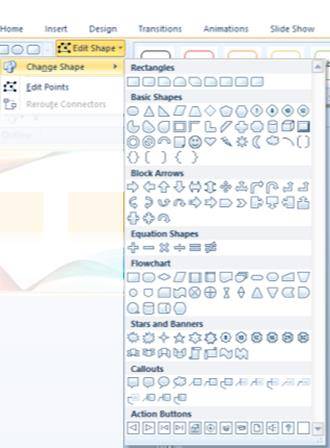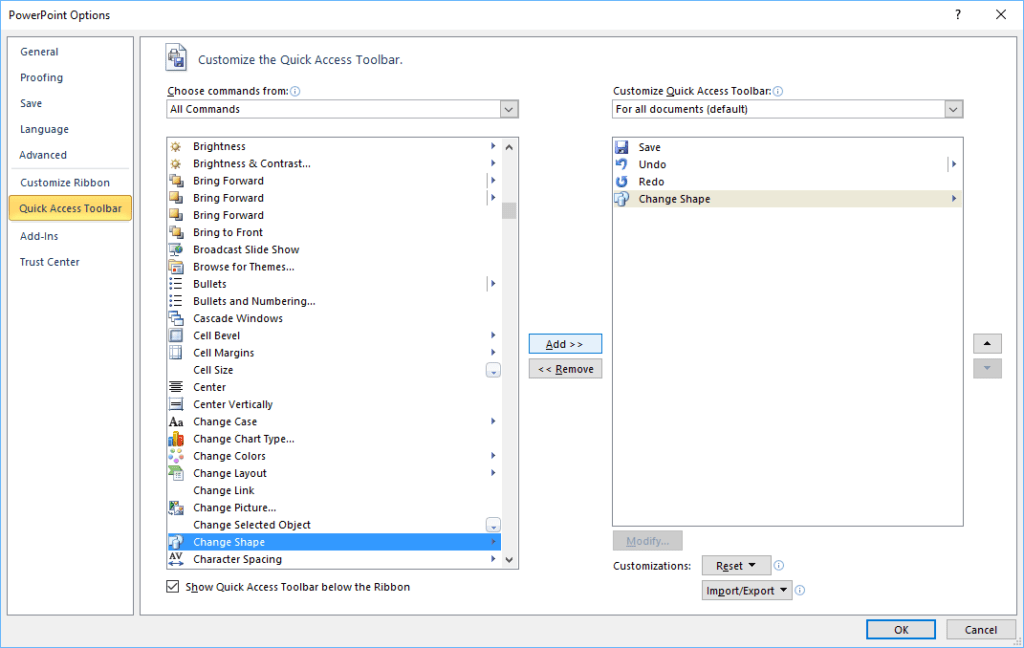2 Ways to Change Shapes in PowerPoint
by Avantix Learning Team | Updated August 23, 2021
Applies to: Microsoft® PowerPoint® 2010, 2013, 2016, 2019 and 365 (Windows)
When you create shapes in PowerPoint, they are created as vectors. You can apply fills, lines, special effects and animations to shapes you draw and they can be resized with no loss in quality. If you decide you want to change a shape but maintain all of the formatting and animation settings, you can do that easily by changing the shape to another shape. There are a couple of ways to change shapes in PowerPoint.
Note: Buttons and Ribbon tabs may display in a different way (with or without text) depending on your version of PowerPoint, the size of your screen and your Control Panel settings. For PowerPoint 365 users, Ribbon tabs may appear with different names. For example, the Picture Tools Format tab may appear as Picture Format and the Drawing Tools Format tab may appear as Drawing Format or Shape Format.
Recommended article: 10 Great PowerPoint Drawing Tricks and Shortcuts
1. Changing shapes using the Ribbon
You can click on the Edit Shape button on the Format tab in the Ribbon to access the Change Shape gallery to change shapes.
Below is the Change Shape gallery (it may have a different appearance depending on version, monitor size and Control Panel settings):
To change shapes using the Ribbon:
- In Normal View, select a PowerPoint shape on a slide. You can also select multiple shapes by Shift-clicking or Ctrl-clicking the shapes.
- Click the Drawing Tools Format, Drawing Format, or Shape Format tab in the Ribbon.
- In the Insert Shapes group, click the arrow beside Edit Shape to display a drop-down menu.
- Select Change Shape and then click another shape in the gallery. You can also navigate in the gallery using your arrow keys and press Enter to make a selection. The shape will change but maintain the formatting and animation settings.
2. Changing shapes using the Quick Access Toolbar
It's helpful to add the Change Shapes command to the Quick Access Toolbar.
Below is the Options dialog box where you can add a command to the Quick Access Toolbar:
To change shapes using the Quick Access Toolbar:
- Add the Change Shapes button to the Quick Access Toolbar by clicking the File tab in the Ribbon and then selecting Options.
- In the categories on the left, select Quick Access Toolbar.
- In the menu below Choose commands from, select All Commands.
- In the list of commands, click Change Shapes.
- Click Add.
- Click OK. The command will be added to the Quick Access Toolbar.
- In Normal View, select a PowerPoint shape on a slide. You can also select multiple shapes by Shift-clicking or Ctrl-clicking the shapes.
- Click the Change Shapes command on the Quick Access Toolbar.
- Click another shape in the gallery. You can also navigate in the gallery using your arrow keys and press Enter to make a selection. The shape will change but maintain the formatting and animation settings.
Changing shapes is a real timesaver in PowerPoint. It's unfortunate that it doesn't appear by default in the context menu when you right-click a shape.
Subscribe to get more articles like this one
Did you find this article helpful? If you would like to receive new articles, join our email list.
More resources
How to Print PowerPoint Presentations with Notes
How to Change the Background of Your PowerPoint Slides
How to Use the Eyedropper in PowerPoint to Match Colors
How to Remove the Background of a Picture in PowerPoint (2 Ways)
How to Use the Selection Pane in PowerPoint to Select, Rename, Hide and Reorder Objects
Related courses
Microsoft PowerPoint: Intermediate / Advanced
Microsoft PowerPoint: Design for Non-Designers
Microsoft PowerPoint: Animations Bootcamp
Our instructor-led courses are delivered in virtual classroom format or at our downtown Toronto location at 18 King Street East, Suite 1400, Toronto, Ontario, Canada (some in-person classroom courses may also be delivered at an alternate downtown Toronto location). Contact us at info@avantixlearning.ca if you'd like to arrange custom instructor-led virtual classroom or onsite training on a date that's convenient for you.
Copyright 2024 Avantix® Learning
You may also like
How to Insert or Type E with an Accent Mark in PowerPoint (È, É, Ê, Ë, è, é, ê, or ë)
You can insert or type e with an accent mark in PowerPoint using built-in tools or keyboard shortcuts (including Alt code shortcuts). The letter e can be inserted with an accent in both upper or lower case in text boxes or placeholders on slides, the slide master or layouts. The following are common accents in upper or lower case – È, É, Ê, Ë, è, é, ê, or ë.
How to Fade a Picture or Part of a Picture in PowerPoint (Using a Gradient)
You can fade a picture in PowerPoint by drawing a rectangle shape on top of the picture and then filling the rectangle with a gradient from opaque to transparent. This technique is often used to fade an image into the background of a slide. Since the rectangle is placed on top of the image and then text may be placed on top of the rectangle, you may need to reorder the objects.
How to Lock an Image, Shape or Other Object in PowerPoint
You can now lock an image, shape or other object in PowerPoint. Objects can be locked in Normal View or Slide Master View. Only PowerPoint 365 users can lock objects to prevent moving and resizing. This is helpful if you want to select and move other objects on the slide or prevent others from moving or resizing an object. You can lock items using the context menu or the Selection Pane.
Microsoft, the Microsoft logo, Microsoft Office and related Microsoft applications and logos are registered trademarks of Microsoft Corporation in Canada, US and other countries. All other trademarks are the property of the registered owners.
Avantix Learning |18 King Street East, Suite 1400, Toronto, Ontario, Canada M5C 1C4 | Contact us at info@avantixlearning.ca









